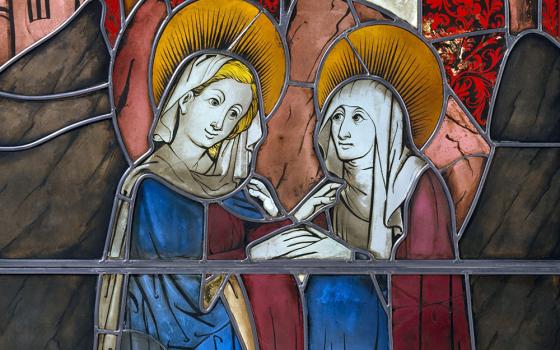Rome
American reaction to Pope Benedict XVI’s latest book, Jesus of Nazareth: The Infancy Narratives, so far has been restricted to quick day-one news pieces, partly because it was released the day before Thanksgiving. (The Vatican isn’t always known for its sense of moment, but let it be recorded that in this case, they managed to get book on shelves just in time for “Black Friday”.)
In fairness, even here in Rome the book hasn’t been a sensation, largely because it doesn’t contain that one thunderclap passage – reevaluating the morality of condoms, for instance (as in Benedict’s 2010 interview book with Peter Seewald), or absolving Jews from collective guilt for the death of Christ (as the pope did in his 2011 volume on Jesus.)
This is Benedict’s third book on the life of Christ, with the first, issued in 2007, focusing on the baptism to the transfiguration, and the second, released in 2011, treating Holy Week. In the prologue, Benedict says this entry isn’t so much a third volume as an “antechamber”.
The quick headlines focused on the pope’ defense of the historical reliability of the infancy narratives – Jesus really was conceived virginally, he insists, there really were Magi, he really was born in Bethlehem, and so on. The pope also sees no reason to doubt that Mary, the mother of Jesus, was a primary source for the infancy narratives.
As with his other two books on Jesus, however, Benedict’s interest is less with the historical dimension of the gospels than their theological significance. His chief aim, he says, is “to help people on their path toward and alongside Jesus.”
Without attempting a book review, which would really require an expert in Biblical studies, the following are four noteworthy points about The Infancy Narratives as read through the eyes of a vaticanista, meaning a journalist who scours papal writings for hints about his approach to church policy.
Between Skepticism and Fundamentalism
Benedict obviously has robust confidence in the basic accuracy of the Biblical tradition. He endorses the position of German Bible scholar Klaus Berger, who argues that in the absence of proof to the contrary, one should assume that the gospel writers got it right, since they were far closer to the events than modern exegetes – and that “mere suspicion” is not sufficient to judge their accounts historically dubious.
On the matter of the virgin birth, for instance, Benedict says it’s a “cornerstone” of the faith: “If God does not have power over matter,” he writes, “then he simply is not God.”
That said, Benedict XVI is clearly no fundamentalist.
For instance, Benedict breezily concedes that it would be impossible to try to reconcile the differences in the genealogies of Jesus presented by Matthew and Luke, saying in both cases their primary interest is the theological and cosmic significance of Jesus’ birth, not the details of his ancestry.
In other words, Benedict isn’t bothered that on certain matters of detail, the gospels appear to contradict themselves.
The pope also has no problem saying that Christian tradition got the date of Jesus’ birth wrong. Rather than what we now regard as the year zero, he says, Jesus was most likely born around 7 or 6 B.C. (As it turns out, there was an astronomic event that year which, as the pope notes, is believed by some to underlie the story of the “star in the East” that led the Magi to Jesus.)
On another score, a pious Catholic tradition has long read Luke 1:34, when Mary asks the Angel Gabriel after he tells her she will conceive a child, “How shall this be, since I have no husband?” to mean that she had taken a vow of virginity. Over the centuries, this tradition has seen Mary as a forerunner of consecrated virginity in the church, especially for women. A quick internet search will turn up any number of Catholic web sites which insist that Mary was a “consecrated virgin of the Lord,” and that Joseph was her guardian or protector.
Noting that such an idea would be “quite foreign to the world of Judaism at Jesus’ time,” Benedict XVI summarily dismisses it as “inconceivable.” (One wonders what all those Catholic apologists who insist on this tradition will make of the pope’s words.)
In general, Benedict argues that the New Testament records real history, but he calls it “interpreted history,” meaning events that actually happened, but as they were “interpreted and understood in the context of the Word of God.” What’s important, he suggests, is not the fine points but the overall theological message.
This approach is consistent with the 2008 Synod of Bishops on the Bible, which aimed to position the Catholic church vis-à-vis the truth of Scripture somewhere between skepticism and fundamentalism.
Classic Ratzinger touches
Those who’ve followed the work of Joseph Ratzinger over the years will recognize in The Infancy Narratives several classic touches.
First, Benedict XVI argues that the spiritual worship taught by Jesus was not a radical break with the Old Testament tradition of a sacrificial cult. Instead, the pope insists, the Old Testament priesthood was a “path” toward Jesus, and there’s a “development” in priestly spirituality discernible from the Old Testament through the gospels.
In effect, that’s a sort of scriptural version of Benedict’s famous argument for a “hermeneutic of reform … of renewal in continuity” as the right way to understand the Second Vatican Council (1962-65). Benedict tends to see new phases in the life of the church neither as a break with the past, nor a simple recapitulation of it. In his mind, they’re developments that bring the past along and give it new life.
In a similar vein, Benedict insists that Jesus was not a “liberal or a revolutionary,” and that his criticism of Israel’s “false piety” was not meant to upend the entire Old Testament tradition embracing both the law and the prophets.
Second, a striking feature of Benedict’s personality is the serenity he exudes in the midst of crisis and scandal – and his papacy hasn’t suffered any shortage of either one. A chief reason is his conviction that the celebrated events of today will quickly fade, while the real forces shaping culture and history often pass unnoticed.
Whether that’s laudable perspective or a prescription for indifference may be a matter for debate – if it isn’t actually both. In any case, it’s part of the pope’s makeup, and we get another small glimpse of it in the book.
Discussing the appearance of the Angel Gabriel to Zechariah to announce the birth of John the Baptist, Benedict writes: “The hidden event that takes place during Zechariah’s evening sacrifice, unnoticed by the vast world public, in reality ushers in the eschatological hour – the hour of salvation.”
For good or ill, it’s simply part of Benedict’s character to think that things “unnoticed by the vast world public” are more important than the stuff that dominates headlines in the here-and-now.
Third, there’s a vintage Ratzingerian dig at the professional theological guild, delivered the way only someone who used to move in that world could do.
Discussing the scene in which the Magi ask the chief priests and the scribes where the messiah is to be born, Benedict notes that the religious authorities answered the question, but “do not feel prompted to take any practical steps as a result.” In other words, they tell the Magi where to expect Christ – “in Bethlehem in Judea” – but they don’t seek him out themselves, or embrace his message.
Thus the pope’s subtle swipe: “Does this, perhaps, furnish us with the image of a theology that exhausts itself in academic disputes?”
The Danger of Power
Famously, Lord Acton’s line that “power tends to corrupt, and absolute power corrupts absolutely” was coined with respect to the papacy. At a common sense level, most people consider popes to be fairly powerful figures – a perception backed up by canon 331 of the Code of Canon Law, stating that popes possess “supreme, full, immediate and universal ordinary power in the church.”
Yet as he has on other occasions, Benedict XVI uses The Infancy Narratives to issue a warning to Christians about the dangers of proximity to power – specifically, the negative effects of becoming mixed up with this-worldly systems of authority.
It’s not so much that power corrupts, as Benedict sees it, but that power “disfigures.”
In the context of discussing the kind of kingdom which the birth of Christ promised, Benedict writes: “Jesus’ words to Pilate remain perennially true: ‘My kingdom is not of this world.’ In the course of history, the mighty of this world have sometimes tried to align it with their own [kingdoms], and that’s when it is put at risk. They seek to link their power with Jesus’ power, and in the process they disfigure his kingdom and endanger it.”
Benedict adds, “Or else it is subjected to constant persecution by rulers who will tolerate no other kingdom than their own, and would like to destroy this powerless king, whose mysterious power they fear.”
Notably, the pope seems to lay the blame for this temptation to blur throne and altar mostly on the side of the throne, suggesting it’s the “mighty of this world” who try to co-opt Christ for their own ends. While there are certainly examples of that, both historically and in the present, critics might argue that sometimes the temptation percolates on the side of the altar too – that church leaders themselves sometimes aspire to worldly power, and the privilege it brings.
In any event, Benedict’s language stands as a caution about the “disfiguring” consequences that result when the church is enlisted on behalf of politics. It would be an interesting thought exercise to ponder what that implies today – especially, perhaps, for Americans in the wake of the 2012 elections.
Humility and Joy
It’s always interesting to know what a pope considers to be the hallmarks of authentic Christian life. One can argue over whether his policies are actually promoting those qualities, of course, but it’s still useful to have a clear sense of what he’s looking for.
In The Infancy Narratives, Benedict suggests two such hallmarks: humility and joy.
Humility comes up as Benedict discusses the two annunciation scenes in the infancy narratives, that of the birth of John the Baptist and that of Jesus. The former, he notes, features a priest of Israel receiving a visit from an angel during the Temple liturgy, while the latter involves an unknown woman in simple surroundings living in a town, Nazareth, which has no real significance in the Old Testament.
Here’s what Benedict deduces from the contrast: “The sign of the New Covenant is humility, hiddenness – the sign of the mustard seed. The Son of God comes in lowliness.”
The stress on joy, meanwhile, comes out of Benedict’s discussion of the annunciation to Mary. He notes that Gabriel does not employ the usual Jewish greeting with Mary – shalom, or “peace” – but the Greek term chaĩre, which tradition renders as “hail,” but which really means something like “rejoice!”
“Joy appears in these texts as the particular gift of the Holy Spirit,” the pope writes, “the true gift of the redeemer.”
Benedict also notes that in Greek, the terms “joy” and “grace” share the same root. As he puts it, therefore, “joy and grace belong together.”
There you have it: According to Benedict XVI, humility and joy are core tests for Christian authenticity. Let the conversation begin about whether those two qualities are actually characteristic of Catholic life in the early 21st century.




